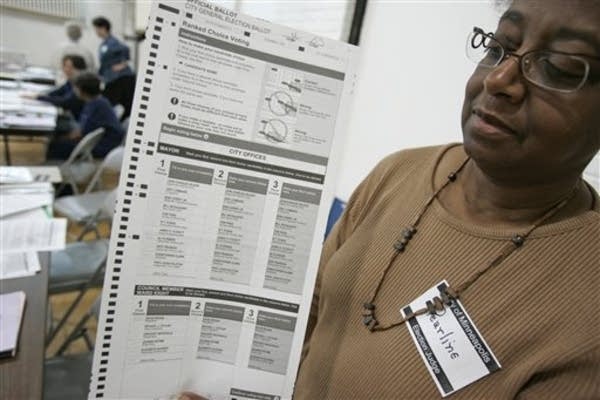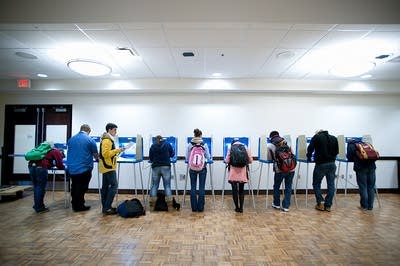Minneapolis voting: More poll workers, better voter education planned
Go Deeper.
Create an account or log in to save stories.
Like this?
Thanks for liking this story! We have added it to a list of your favorite stories.

City elections officials want to make this fall's election go more smoothly than in past years.
Plans announced on Wednesday focus on shortening wait times at Minneapolis polling places, increasing voter education efforts and reducing the amount of time it will take to count the cast ballots.
Last November, in a presidential election year, voters faced long lines at several city polling places. Some voters waited in line only to find out they were in the wrong place after some precinct boundaries were redrawn.
More poll workers this fall will be assigned to each site, Assistant city clerk Grace Wachlarowicz said. She said the presence of additional staff will give judges more time to concentrate on their primary duties.
Turn Up Your Support
MPR News helps you turn down the noise and build shared understanding. Turn up your support for this public resource and keep trusted journalism accessible to all.
"This will give them an opportunity to focus strictly on poll management, assist voters where they need to, answer questions, manage the lines. That will be their sole responsibility -- is management," Wachlarowicz said.
City elections officials expect a higher than normal turnout in November, with a hotly contested mayoral race on the ballot, and several competitive city council races.
Wachlarowicz said the city plans a vigorous voter education effort to ensure people know where they are supposed to vote and to also familiarize them with the city's relatively new voting system. This fall will be Minneapolis' second election using ranked-choice voting, also called instant runoff voting. The system allows voters to select a first, second and third choice candidate. In 2009, the first city election using the system, it took more than two weeks to hand-count the ballots.

Hand-counting was necessary because the voting machines were not certified to tally multiple-choice votes. However, city clerk Casey Carl said this fall the city plans to use new machines with software designed to streamline the process. The software will be able to export the multiple-choice selections into a computer spreadsheet -- a task that had to be done by hand in 2009, Carl said.
"What the export file will allow us to do is skip two phases: the hand count and the data entry -- which are, by the way, the most timely and the most expensive," Carl said.
He said the version of the software that includes that feature has not yet received the necessary state certification, but believes it will be by fall.
However, additional software components, like the one that would allow workers to skip the most time-consuming tasks, can't be certified by federal or state authorities because there are no federal or state standards to hold them to, Carl said. He said the city will ask an independent organization to test the software components.
"And that way we're getting additional assurance for our voters and for the city that, yes, the use of these new enhancements that are available in version 5.1 have been tested and found to be completely operational according to our specifications," Carl said.
A city report says voting system components related to ranked-choice voting occupy a gray area in state law. "Federal testing is based on standards established in 2005, and those standards do not address a voting system designed to accommodate alternative voting methods like RCV," reads the report. "Similarly, Minnesota election law is silent on RCV; consequently, the Secretary of State has no authority to certify RCV-specific components of a voting system."
Carl said if the new software program and its new features are approved, election results may be ready in a few days -- not a few weeks, as was the case four years ago.




